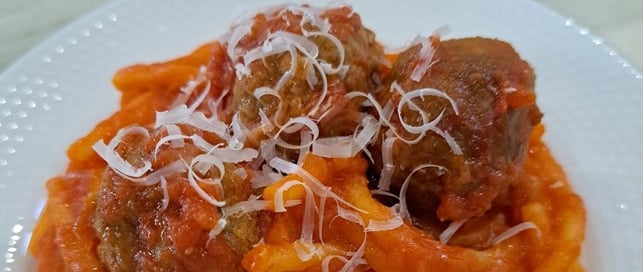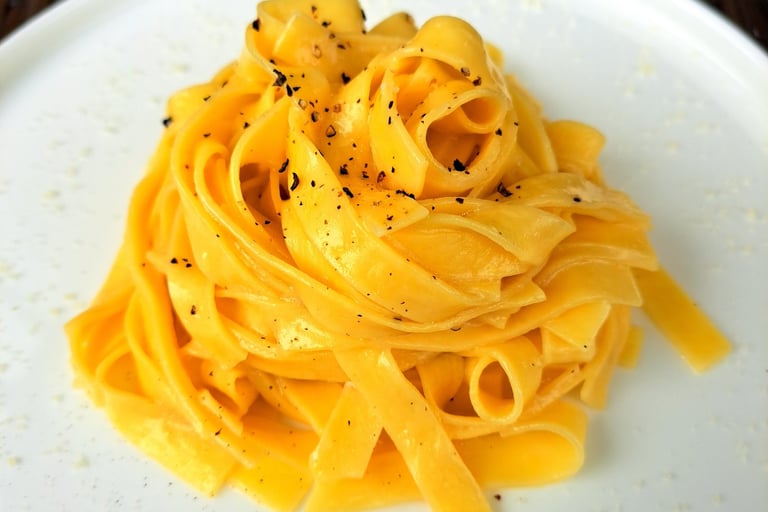Spaghetti and Meatballs. Are they really an Italian dish?
Discover the truth behind America's favorite 'Italian dish' that isn't authentically Italian at all. Explore the fascinating world of American Italian food and its unique twists on traditional Italian cuisine.
The Cook Lab
10/26/20255 min read


One of the most iconic scenes in Disney animation features two love-struck dogs sharing a romantic dinner behind an Italian restaurant in America. They’re enjoying a lavish plate of spaghetti topped with giant meatballs, and as they slurp up the same strand of pasta, their noses meet in a sweet kiss.
For many Italians, that was probably their first encounter with Italian-American cuisine.
Spaghetti? Sure (maybe cooked a bit more al dente, but let’s not nitpick). Meatballs in tomato sauce? Absolutely. But combining the two? That’s not something you’ll find in traditional Italian cooking. In Italy, meatballs are sometimes used in pasta dishes—especially in Abruzzo—but they’re usually small, bite-sized morsels, not golf-ball-sized (or even tennis-ball-sized) giants.
Spaghetti with Meatballs and Other Italian-American Dishes
Thanks to the internet and social media, we’ve discovered a whole range of dishes Americans associate with Italian cuisine—many of which are virtually unknown in Italy.
Yet for an American, it’s totally normal to walk into the most popular Italian restaurant in town and find dishes like Alfredo pasta, spaghetti and meatballs, chicken piccata, veal marsala, and various meat parmigianas. Are these dishes completely foreign to us? Not exactly. Many of them have roots in homemade recipes that, over time and thousands of miles, evolved into something quite different.
Take pasta alla vodka, for example. Anyone who lived through the 1980s will remember it as a staple on pub and bistro menus, right alongside salmon pasta. It eventually faded from popularity in Italy, but in America, it rose from the ashes and became a classic.
Most Italian-American cuisine arrived with the wave of immigration between 1880 and 1920. Immigrants landed at Ellis Island with cardboard suitcases, big dreams, and empty stomachs. Many were fleeing poverty (like Italians), famine (like the Irish, due to the potato blight), or persecution (like Eastern European Jews). In America, they found refuge, opportunity, and—most importantly—plenty of food, especially meat.
As for pasta, options were limited. Spaghetti was often the only type available. And tomatoes? Forget the sun-ripened beauties of southern Italy—here, it was all about canned tomatoes. From these humble ingredients, spaghetti with meatballs was born. And yes, it’s true: everything really is bigger in America. Including the meatballs.
A classic plate of spaghetti with meatballs typically includes:
3 large meatballs
120–130g of pasta
A ladle of marinara sauce (tomato, oregano, and lots of garlic)
A generous sprinkle of Parmesan
From these immigrant kitchens, American food culture grew alongside its Italian roots. If you look closely, you’ll always find a traditional base. Pepperoni pizza, for instance, isn’t far from our diavola with spicy salami. The confusion comes from the word “pepperoni”—which to us means bell peppers, but in the U.S. refers to spicy sausage (from “pepper sausage”).
Alfredo Pasta and Hollywood Glamour
Alfredo pasta dates back to the 1920s, when Hollywood stars Douglas Fairbanks and Mary Pickford tasted butter-and-cheese pasta at Alfredo alla Scrofa in Rome. They raved about it back home, and soon every colleague visiting Rome made a pilgrimage to try it. The dish became wildly popular in America—but to compensate for lower-quality cheese, the recipe morphed into a creamy white sauce made with cheese, cream cheese, thickeners, butter, and other ingredients far removed from the original.
Southern Roots and Little Italy
Dishes like veal marsala, chicken piccata (chicken with lemon and capers), and ricotta lasagna come from specific regions of Italy and may be unfamiliar to many Italians. But in Little Italy, they found fertile ground to become part of the “traditional” Italian-American menu. Since most immigrants came from southern Italy, it’s no surprise that Italian-American cuisine is rooted in southern flavors: olive oil, garlic, oregano, mozzarella, Parmesan, lemon.
A New Era of Italian Cuisine in the U.S.
Thanks to the internet, budget travel, expats, and young entrepreneurs investing in restaurants, the quality of Italian food in the U.S. has improved significantly. Not everywhere, of course—but in major cities like New York, Miami, San Diego, and Los Angeles, it’s easy to find restaurants offering high-level regional Italian cuisine.
In Miami, for example, you’ll find stuffed pasta from Emilia-Romagna, Ligurian focaccia di Recco, Sardinian suckling pig, and Neapolitan pizzas that rival those from Naples. Still, educating the American palate to appreciate these “authentic” flavors is a work in progress.
A couple of years ago, a local Instagram food critic harshly dismissed pansotti with walnut sauce from a Ligurian restaurant in Wynwood, calling them “tasteless.” The focaccia di Recco was described as “flat, with a weird, bland cheese.” Maybe that’s why someone recently sent me a photo from a famous Italian pizza counter… featuring chicken parm pizza. Well, rent’s gotta get paid 😉
Lady and the Tramp’s Spaghetti with Meatballs
To stay on theme this month, here’s the original recipe from a well-known Italian-American restaurant in Fort Lauderdale. Every year, two top restaurants in the city compete in a meatball contest, with proceeds going to a local children’s hospital. This recipe was a finalist last year, created by Chef Martorano, a Philadelphia-born Italian-American who’s earned the title “The King of Meatballs” thanks to his Fort Lauderdale restaurant.
Lady and the Tramp’s Spaghetti and Meatballs
Serves 6
Meatballs:
500g ground beef (15–20% fat)
1 stale bread roll
1 small bunch of parsley (about ⅓ of a bunch)
⅓ cup warm whole milk (or plant-based milk or cream)
1 tsp salt
½ tsp freshly ground black pepper
1 garlic clove
1 large egg
60g grated Parmesan
1 cup chicken or beef broth (can use bouillon)
2 tbsp instant mashed potato flakes
Instructions:
Preheat oven to 380°F (193°C).
Tear half the bread into 1–2 cm pieces and soak in water. Knead until the milk is fully absorbed.
Blend garlic, parsley, and remaining bread in a small food processor.
In a bowl, mix the beef with the egg, parsley mixture, potato flakes, and Parmesan until smooth.
If the mixture is too soft, add more potato flakes. If too firm, add a bit more milk.
Shape into walnut-sized balls.
Place on a parchment-lined baking tray and bake for 15 minutes (or use an air fryer).
Once firm, transfer to the sauce, add broth, and bake covered at 330°F (165°C) for 30–60 minutes.
Marinara Sauce:
1 chopped yellow onion
1 chopped garlic clove
1 large can of whole peeled tomatoes or 1 small can of crushed tomatoes (avoid calcium additives)
3 tbsp olive oil
Salt and pepper
Instructions:
In a heavy-bottomed pot or Dutch oven, sauté onion and garlic in olive oil until golden.
Lower heat and add tomatoes (crushed or chopped).
Simmer for 15–20 minutes.
Season with salt and pepper (or bouillon if needed).
Add meatballs and bake in sauce at 330°F for 30–60 minutes.
Meanwhile, boil water and cook 600g of spaghetti. Drain and toss with sauce, top generously with Parmesan or Pecorino Romano, and—if you like—add a dollop of whipped ricotta.
Notes:
Always choose tomatoes without calcium salts, which prevent them from breaking down into a smooth sauce.
Baking the meatballs ensures even cooking, prevents breakage, and avoids sticking.
For appetizer-style meatballs, skip the sauce: coat raw meatballs in breadcrumbs and Parmesan, spray with oil or butter, and bake at 400°F (204°C) for 15–20 minutes until golden.
You can double the recipe and freeze the meatballs raw or cooked in sauce—perfect for quick dinners or lunchboxes.








